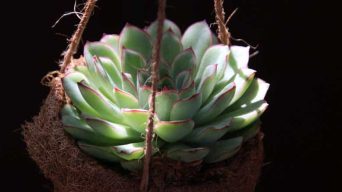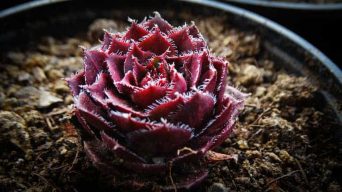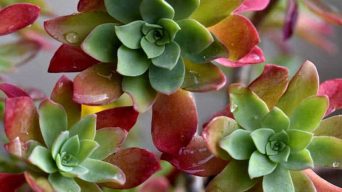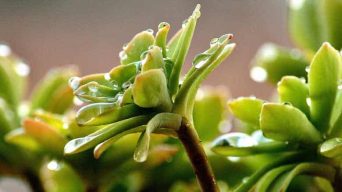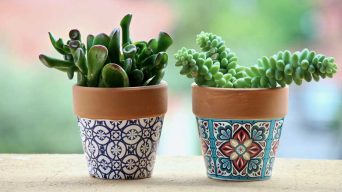Succulents can be an easy and fun way to bring the outside inside. They are also an excellent option for those who want to grow plants but have very little time or space for gardening.
But can succulents grow in water? What are the pros and cons of growing them in water?
Here you’ll find a complete guide that explores what types of succulents are best suited to growing in water, how to get started with growing them, and tips on how you can care for them properly.
Can Succulents Grow in Water?
Yes, succulents can grow in water. Succulents can grow in water because they can store enough nutrients inside the cells of their leaves and stems to survive for a long time without soil.
When grown in water, they can grow much more quickly than when grown in soil and can be easier to care for because they are not prone to diseases from the soil.
However, succulents can only survive in water for a limited time. They need enough light, nutrients, and air to grow just as they do when planted into soil.
If they are not provided with any of these three things, the succulents will eventually die.
Pros and Cons of Growing Succulents in Water
Growing succulents in water have both advantages and disadvantages. It’s essential to be aware of them before deciding whether or not you want to try it.
Pros:
They Grow Faster
Succulents can grow very quickly. Growing in soil can take weeks or months to start producing roots, while a new plant can be grown in water within days.
If you can’t wait for a thriving plant, growing succulents in water is the way to go.
They Can’t Dry Out
A succulent plant grown in soil may die if it doesn’t receive enough water when needed. A succulent grown in water will adjust its growth patterns accordingly.
Maintaining their moisture levels is much easier when they can’t dry out.
There Is No Risk of Overwatering
Succulent plants are a low-maintenance option because they only need watering occasionally and prefer dry conditions (which helps prevent rot).
However, another benefit of growing them in water is that it removes the risk of overwatering — one common mistake novice gardeners make when caring for these plants.
Water Propagation Is Faster
Water propagates the plant much more quickly than soil.
A succulent grown in dirt can take two to three years before you can harvest or trim it without the risk of damaging the roots and killing the plant.
You can do so within days with water propagation.
They Will Need Less Care and Attention
One of the major advantages to growing succulents in water is that they will need less care and attention than if you were to grow them in soil.
If you don’t have a green thumb, this can be a good option for people who want plants but not too much work.
Cons:
Not All Types of Succulents Thrive in Water
Some succulents, like cacti, can’t grow in water and must be kept on a dry surface.
They cannot thrive if submerged or surrounded by too much moisture.
They Don’t Last Long in Water
Succulent plants don’t last as long when grown submerged underwater. It’s best not to submerge them for more than six months before reevaluating.
They Are Prone to Root Rot
They are prone to root rot because they don’t have soil with beneficial microbes to break down nutrients into accessible forms.
This means your succulents may need frequent repotting when growing in water and adding fertilizers throughout their life span.
Not Recommended for Outdoors
When your goal is to grow succulents indoors for decorative purposes only (and not outdoors), you can use these techniques.
But when your goal is to grow succulents outdoors, it would be better to use more traditional methods. Planting them in containers with good drainage and using a cactus potting mix is better.
Can Lead To Stunted Growth
Growing succulent plants in water do not provide enough oxygen, which means these types of succulents may suffer more when compared with those grown immersed or planted in soil.
This can lead to stunted growth, frustrating for the gardener.
They Don’t Have Enough Nutrients
Succulents that grow in water do not absorb as many nutrients from the water because they don’t have any soil to help them extract it.
The best way to provide enough nutrients is by adding fertilizer before planting and every few weeks after, depending on how quickly your plant grows.
It might also take some time for your plant to adjust. Check back regularly for signs of stress, like drooping leaves or wilted stems, and make adjustments accordingly if necessary.
Suitable Types of Succulents To Grow in Water
Some types of succulents are more suited to grow in water than others. Some of the most popular ones include:
Crassula Ovata “Jade Plant”
The Crassula ovata, sometimes called the Jade Plant or Money Tree plant, is a popular houseplant found in most nurseries.
It’s easy to take care of due to its incredible ability to store water inside its leaves – making them perfect for growing succulents in water.
Crassula ovata has small white flowers that bloom after dark. They typically last only one night before wilting away but are still pretty nonetheless!
These succulents don’t need as much light as other varieties do. They’re perfect for growing indoors or outside during wintertime when most other succulents aren’t doing well without sufficient sunlight.
Cotyledon Orbiculata “Pig’s Ear”
Cotyledon orbiculata is a very popular succulent for growing in water. It has long, thin leaves and can grow as tall as eight inches with time.
The “Pig’s Ear” is an excellent choice because it can tolerate drought conditions while also being tolerant of high temperatures that would kill other types of plants.
As this plant’s name suggests, the colors on its leaves turn into shades of yellow or gold when exposed to sunlight.
Echeveria Metallica
Echeveria Metallica, also known as the “Mexican Snowball” or the “Patio Plant,” is an excellent choice for succulents growing in water.
These plants are native to southern Mexico and Guatemala. They enjoy a semi-arid climate with rainfall concentrated in the winter months.
Their foliage consists of rosettes of fleshy leaves, ranging from light green to dark purple, depending on exposure to sunlight.
The leaf margins may be jagged or serrated and have a sawtooth texture. Flowers are small but showy, typically white tinged with pink or red coloration at their center.
Sempervivum Tectorum
Sempervivum tectorum is one of the most popular types of succulents to grow in water. They grow well when planted horizontally with just their underwater roots (but not so deep you can’t see them).
This plant can tolerate various soil and environmental conditions and grow well indoors or out.
It has beautiful rosettes that range from deep green to bright yellow, depending on how much light they receive. It also has a variety of sizes so that you can get small and slow-growing types or large ones.
How To Grow Succulents in Water
To grow succulents in just water, we must take the following steps:
First, we must choose a container that is big enough for the succulent. Remember: never plant in water-filled containers because they can’t breathe properly!
Second, fill up the container with clean water until it reaches just below the roots of your chosen succulents and allow them to soak overnight. The next day, you should remove any floating plants or residue from this step before planting again.
Third, you can decide whether to fertilize your succulents (optional). Generally, most people don’t use fertilizer when growing their succulents in water.
Still, if you want yours to grow faster, adding some food, like liquid kelp, might be worth adding to the mix after soaking them overnight. A diluted liquid kelp solution can make succulents healthier and more robust.
Fourth, you must remove the spent water at least once a week (or more often if it is warm outside). This means removing any floating plants or residue from this step before replacing it with new clean water.
You should replace it with fresh water every month if some minerals are built up over time!
Finally, keep an eye on the pH level of the container because it can affect how quickly your plant grows and its health overall, so remember to frequently check for changes in coloration, which could indicate something’s wrong, like too much acidity.
I recommend watering these plants one last time until they’re fully submerged rechecking them in a few days to see how they’re doing.
How To Take Care Of Succulents in Water
The following are necessary steps to care for succulents grown in water and make them thrive.
- Change the water in the container every week.
- Make sure to change up where you place your succulent (once a month).
- Put an air stone into the water just before adding any plants. This will help mix oxygen levels with fewer bubbles and provide more CO₂ for plant growth.
- Leave some space” between each of your plants when they are submerged. Let sufficient room for them to grow without being crowded or crowding other plants.
- Use sand on the bottom of your pot instead of gravel. Sand is easier to clean out, and it takes less time.
- Do not allow roots to stay in water for more than a week, and ensure air bubbles are coming up from the bottom.
- Ensure plants get enough light (preferably sunlight) when growing succulents indoors. They can also be grown outdoors on patios or decks, but their growth will depend on how much sun they receive daily. If you need to, use grow lights in the winter because they don’t get as much natural light.
- Use fertilizer every two weeks to stimulate growth.
- Rinse plants with clean water every week to keep them healthy and happy. Leaves should be green and firm, not drooping or wilting (if so, they need more light).
- Prune off any dead leaves that fall from the succulent by cutting back stems as close to the base of the leaf as possible. This can help your succulents grow faster, giving them space for new growth and air circulation, which speeds up photosynthesis in most cases.
How to Transplant a Succulent From Water to Soil
To transition your succulents from a water environment to soil, you can follow these steps:
- Be sure to wash your hands before removing the succulent from the water.
- Remove the succulent from its pot and gently squeeze it to remove any excess water. Be careful not to damage the fragile stem and leaves of the plant during this delicate process.
- Gently loosen the roots with your fingers or a chopstick to make them less dense.
- Add some soil around your succulent roots, making sure that they are completely covered by soil.
- Pat it so that there is no air inside the pot; this will prevent mold from growing on the surface of your soil.
- Water the soil occasionally and make sure that it has good drainage so water can seep out of the bottom when you pour some on top.
- Place your succulent in a sunny area or near a window to get as much light as possible. Make sure that the light can reach all parts of the plant.
Can Succulents Grow in Water Beads?
Yes, you can grow succulents in water beads. They may not be as robust or long-lasting as the ones grown in soil.
However, they are still pretty easy to care for and can take various forms, from tabletop plants that need minimal attention to more extensive outdoor arrangements.
Growing plants in water beads can be an excellent alternative for those who do not have much space or time to care for their houseplants.
Succulents are perfect candidates because they require little maintenance and can thrive on neglect, provided you keep them watered.
You may still want to use an organic fertilizer once every two weeks while the plant is growing; however, this should depend on your specific type of succulent.
Many different types of succulents grow well in water beads: Jade Plant (Crassula ovata), Hens-and-Chicks (Sempervivum tectorum), String of Pearls (Senecio rowleyanus), Sempervirons, Cobweb Houseleek (Sempervivum arachnoideum), and the Golden Pathos.
Most succulents grow best if they are left dry for a few days between watering sessions. Still, you can water every two to three weeks without the risk of root rot or over-watering in this case.
However, it would help if you kept your original water beads wet until there’s enough room for them to soak up more liquid. Otherwise, some parts may not get any moisture at all.
If you notice these areas are drying out before adding new water beads, transplant those plants into regular soil instead. The change could help alleviate stress on the roots from maintaining too much surface area with no available oxygen.
Final Thoughts
Growing succulents in water can be a good option for those who don’t want to maintain soil pots. It might even make your plants grow faster than if you just planted them into a potting soil mix.
However, you must provide enough light, air, nutrients (such as fertilizer), and space so that the plant doesn’t dry out or suffocate from lack of oxygen.
Otherwise, your succulents will likely end up dying quickly because there isn’t anything holding their roots to the earth.


